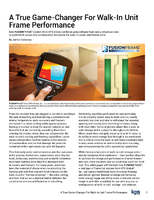Wafer Bonding Machine produces 3D LSI circuits at room temp.
Press Release Summary:
Utilizing fast atom beam gun to irradiate atoms for activating material surface, Bond Meister MWB-12-ST can provide continuous bonding of up to five 12 in. wafers and perform wafer transfer and alignment for automatic bonding. FAB gun effectively removes oxide film on surface of bonding metal material that normally impedes bonding. By eliminating heating process, room-temperature bonding frees devices from heat stress and eliminates need for heating/cooling cycle.
Original Press Release:
MHI Develops World's First 12-inch Wafer Bonding Machine Capable of Producing 3-D Integrated LSI Circuits at Room Temperature
Tokyo, - Mitsubishi Heavy Industries Ltd (MHI) has developed the world's first fully automated 12-inch (300 millimeters) wafer bonding machine, dubbed the "Bond Meister MWB-12-ST," capable of producing 3-dimensionally integrated LSI (large-scale integration) circuits at room temperature. The company delivered the first unit to the National Institute of Advanced Industrial Science and Technology (AIST). Leveraging the new machine's ability to eliminate heat stress and strain in the bonding process and help achieve high productivity, MHI looks to contribute to efforts to further enhance the capacity and performance of LSIs, which currently face limitations in miniaturization.
In lieu of a conventional ion beam gun, the Bond Meister MWB-12-ST adopts a fast atom beam (FAB) gun to irradiate atoms for activating a material surface to bond. Whereas an ion gun radiates an argon ion beam, an FAB gun radiates a neutral atom beam of argon. The FAB gun, which features about 20 times greater energy per particle than an ion gun, is capable of effectively removing oxide film on the surface of the bonding metal material that normally impedes bonding. Up to 20-ton weight loading is applicable for bonding.
The new system is able to undertake continuous bonding of up to five 12-inch wafers and can perform wafer transfer and alignment for automatic bonding. The machine is also capable of preliminarily setting the bonding conditions for each wafer individually, to accommodate production of various types in small lots.
AIST is an advanced public research institute involved in industrial technology fields. It has abundant accumulated technological knowhow including the area of room-temperature bonding, a technology that originated in Japan. Through the adoption and utilization of the MWB-12-ST at the institute, MHI hopes the new machine and its technology will contribute significantly to technological advancement of semiconductor-related industries.
MHI's room-temperature bonding machine bonds various materials, such as silicon and metals, at room temperature by radiating an ion or atom beam on the surface of the bonding material - a process that has conventionally been performed by heating. By eliminating the heating process, room-temperature bonding not only frees devices from heat stress and strain, thereby enabling rigid and highly reliable bonding, but also reduces processing time by eliminating the need for a heating/cooling cycle. These advantages, coupled with automated wafer alignment, enable room-temperature bonding to achieve significantly shorter production time and a higher yield ratio, thus realizing reductions in device production costs.
Since its launch in 2006, MHI has expanded its room-temperature bonding machine portfolio steadily, including an 8-inch (200 millimeters) wafer bonding machine introduced earlier for 3-D integrated LSI production. At the same time the company has also established a business structure to support a variety of needs from MEMS (micro-electro-mechanical systems) manufacturers. With the addition of the latest 12-inch wafer model, which will enable low-cost volume production of IC chips, MHI will facilitate the production of memory chips and microprocessor units (MPU), for which demand is robust but the market is highly competitive.
Today, ongoing size reduction and further functionality enhancement of electronic hardware are supported by large-capacity, high-performance LSIs. As further enhancement of LSI integration through miniaturization on two-dimensional (plane) surfaces is reaching a limit, 3-D integration is seen as a promising breakthrough technology to solve this matter. With 3-D LSI circuits, the key lies in achieving technologies for creating electrodes through multiple layers, in order to send signals between layered wafers, and for bonding electrodes with high reliability. MHI's room-temperature bonding technology enables secure alignment with higher accuracy than heated bonding and realizes repeated wafer-layer bonding without heat stress.
Going forward, MHI will further intensify its proposal-based approach to potential customers to expand the adoption of room-temperature bonding as a key technology for 3-D LSI circuit production.
About Mitsubishi Heavy Industries
Mitsubishi Heavy Industries, Ltd. (TSE: 7011, 'MHI'), headquartered in Tokyo, Japan, is one of the world's leading heavy machinery manufacturers. MHI's diverse lineup of products and services encompasses shipbuilding, power plants, chemical plants, environmental equipment, steel structures, industrial and general machinery, aircraft, space rocketry and air-conditioning systems. For more information, please visit the MHI website at www.mhi.co.jp.




